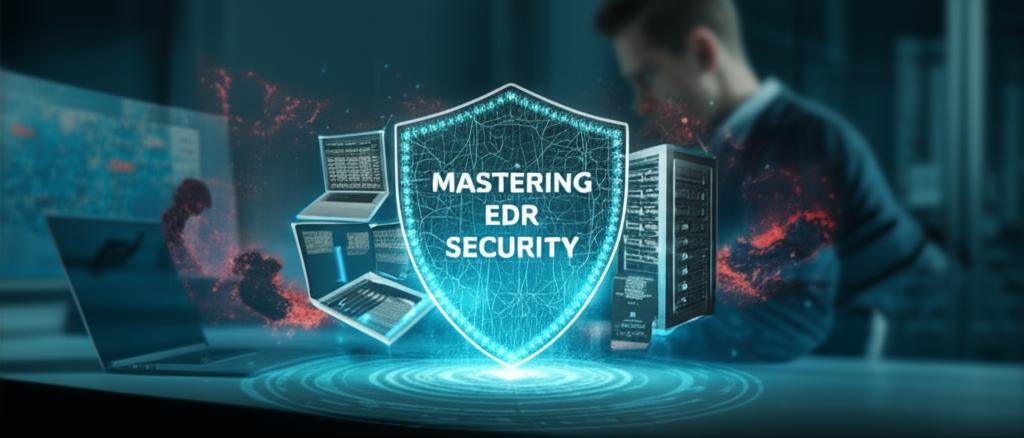Mastering EDR Security: Your Crucial Guide to Next-Gen Endpoint Protection
In today’s ever-evolving digital landscape, traditional cybersecurity measures are no longer sufficient to combat sophisticated cyber threats. This is where EDR Security, or Endpoint Detection and Response, steps in as a pivotal solution. EDR security offers advanced capabilities to monitor, detect, analyze, and respond to threats at the endpoint level, providing a crucial layer of defense that goes far beyond conventional antivirus.
What is Endpoint Detection and Response (EDR)?
Endpoint Detection and Response (EDR) is an integrated security solution that continuously monitors and collects data from endpoint devices (laptops, desktops, servers, mobile devices) within an organization’s network. It uses advanced analytics, machine learning, and behavioral analysis to identify suspicious activities, detect threats, and provide the tools necessary for rapid incident response and remediation. Essentially, EDR security gives security teams unparalleled visibility into endpoint activity, allowing them to proactively hunt for threats and react swiftly to breaches.
The Critical Need for EDR Security
Why has EDR security become indispensable? The answer lies in the limitations of traditional security tools and the increasing sophistication of cyberattacks:
- Evolving Threat Landscape: Malware, ransomware, fileless attacks, and zero-day exploits can often bypass signature-based antivirus solutions.
- Increased Attack Surface: With remote work and cloud adoption, the number of endpoints has grown, each representing a potential entry point for attackers.
- Lack of Visibility: Traditional tools often don’t provide the detailed context needed to understand the full scope of an attack.
How EDR Security Works: A Closer Look
EDR security solutions operate through a multi-faceted approach:
- Data Collection: EDR agents installed on endpoints continuously collect a rich stream of data, including process activity, file system changes, network connections, user logins, and more.
- Threat Detection: This collected data is then analyzed in real-time. EDR systems use a combination of known threat indicators, behavioral analytics (identifying deviations from normal activity), and machine learning to detect anomalies and potential threats that might indicate an ongoing attack.
- Investigation & Analysis: Upon detection, EDR provides security analysts with detailed context, timelines, and attack narratives. This helps them understand how an attack unfolded, which systems were affected, and the potential impact.
- Response & Remediation: EDR security empowers security teams to respond immediately. This can include isolating affected endpoints, terminating malicious processes, rolling back system changes, or even automatically blocking future similar threats.
Key Capabilities and Benefits of Robust EDR Security
Implementing a strong EDR security solution offers significant advantages:
- Enhanced Visibility: Gain deep insight into all endpoint activities, revealing hidden threats and attack vectors.
- Proactive Threat Hunting: Security teams can actively search for threats that have bypassed automated defenses, using the rich data collected by EDR.
- Rapid Incident Response: Automate and accelerate the response to detected threats, minimizing dwell time and potential damage.
- Forensic Capabilities: Access historical data to conduct thorough post-incident analysis and understand attack methodologies.
- Reduced Attack Surface: By quickly identifying and neutralizing threats, EDR security helps reduce the overall risk exposure of your organization.
- Compliance Adherence: Many regulatory frameworks require comprehensive logging and incident response capabilities, which EDR security naturally supports.
EDR vs. Traditional Antivirus: A Crucial Distinction
While often confused, EDR security and traditional antivirus serve different, albeit complementary, roles:
| Feature | Traditional Antivirus | EDR Security |
|---|---|---|
| Primary Focus | Prevent known threats (signature-based) | Detect, investigate, and respond to advanced and unknown threats |
| Detection Method | Signatures, basic heuristics | Behavioral analysis, AI/ML, threat intelligence, continuous monitoring |
| Visibility | Limited (file scans) | Comprehensive (all endpoint activity) |
| Response | Quarantine/delete known malware | Isolate, remediate, roll back, hunt for threats, detailed forensics |
EDR security doesn’t replace antivirus; rather, it augments it, providing an essential layer of post-compromise detection and response capabilities that traditional antivirus simply cannot offer.
Choosing the Right EDR Security Solution
When evaluating EDR solutions, consider:
- Scalability: Can it grow with your organization’s needs?
- Integration: Does it integrate with your existing security stack?
- Automation: What level of automated response and remediation does it offer?
- Threat Intelligence: Does it leverage robust, up-to-date threat intelligence feeds?
- User Interface: Is it intuitive and easy for your security team to use?
Conclusion: Fortifying Your Digital Frontier with EDR Security
In an era where cyberattacks are increasingly sophisticated and persistent, robust EDR security is no longer a luxury but a fundamental necessity. By providing unparalleled visibility, advanced threat detection, and rapid response capabilities, EDR empowers organizations to stay ahead of adversaries, protect critical assets, and maintain business continuity. Embrace EDR security to build a resilient and formidable defense against the threats of tomorrow.







